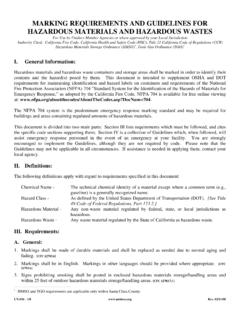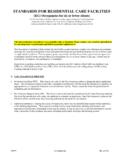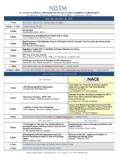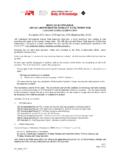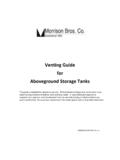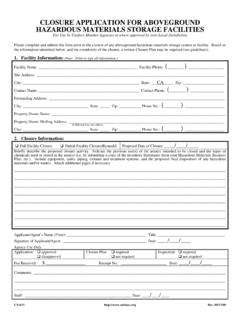Transcription of Closure Guidelines for A/G HazMat Storage Facilities
1 UN-032 - 1/2 05/17/00 Closure Guidelines FOR ABOVEGROUNDHAZARDOUS MATERIALS Storage FACILITIESFor Use by Unidocs Member Agencies or where approved by your Local JurisdictionA. General InformationA facility Closure plan demonstrates that hazardous materials at a closed facility have been transported,disposed of, or reused in a manner which eliminates the need for further maintenance and any threat topublic health and safety or the environment. This document summarizes the requirements for Closure offacilities where hazardous materials have been used, stored, or handled. (Note: Remodels or partialfacility closures may require submittal of elements of a Closure Plan.)
2 1. A Closure permit and payment of appropriate fees may be required for the Closure of any storagesystem which has previously contained any hazardous material. Please contact your local agencyregarding applicable Closure A completed Closure Application for aboveground Hazardous Materials Storage Facilities (ClosureApplication) must be submitted to the appropriate local agency at least 30 days prior to the start ofclosure activities. (Note: Closure permits expire six months after local agency approval of theClosure Application.)3. A facility Closure which includes underground Storage tanks must also include an UndergroundStorage Tank System Closure Permit Application/ Closure A facility Closure which includes aboveground Storage tanks (any container equal to or greater thansixty gallons in capacity) may require additional submittals.
3 Please contact your local agency Please note that local agency requirements ( inspections which may be required, etc.) will bespecified in the Comments section at the bottom of the approved Closure Application. Ifinspections are required please schedule them at least 48 hours in If a groundwater monitoring well is to be closed or destroyed, you must obtain a permit from theSanta Clara Valley Water District [phone no. (408) 927-0710].7. Additional permits ( demolition permits, electrical permits, plumbing permits, etc.) may berequired by the Building Department or other state or federal SubmittalsThe following must be submitted to the local agency before final Closure sign-off:!
4 A completed Closure Application;!A Closure Plan (if required), along with applicable fees;!A Post Closure Report (if required), along with applicable supporting Guidelines for aboveground Hazardous Materials Storage Facilities - Page 2 of 2UN-032 - 2/2 05/17/00C. Closure Plan RequirementsWhen required by the local agency, a Closure Plan would include but not be limited to:!A schedule indicating projected start and completion dates;!A description of the size and type of equipment being closed, and the proposed final disposition.(Note: Equipment includes concrete, piping, duct work, tanks, and all other aboveground hazardousmaterials Storage systems/areas);!
5 A site plan showing the location of the equipment or area being closed. Include all piping andducting to be removed;!A list of the types of chemicals previously used or stored in the area to be closed ( the facility sHazardous Materials Inventory Statements, etc.);!The procedures proposed to be used for decontamination of the facility and equipment (if required)and the proposed method of disposal for all hazardous wastes generated from cleaning procedures may include steam cleaning, rinsing, dismantling and removal ofcontaminated structural and non-structural portions of the building, etc.
6 (Note: Contact the localBuilding Department regarding their requirements);!A brief description of how all hazardous materials will be removed or properly disposed of in amanner which complies with all state and federal laws. A new owner/operator may takeresponsibility for the hazardous materials as long as documentation is submitted which indicatesacceptance of responsibility by the new owner/operator;!A description of the proposed sampling program (if required) including sample locations,constituents to be analyzed for, and test methods to be employed).
7 Samples must be analyzed bylaboratories certified by the State of California to perform the applicable test methods. (Note:Sampling may be required by the local agency if contamination is suspected. An inspector from thelocal agency must be present at the time of any sampling unless prior arrangements have been madewith the local agency.);D. Post- Closure Report RequirementsWhen required by the local agency, a Post- Closure Report would include but not be limited to:!Documentation confirming compliance with all items in the approved Closure Plan;!Confirmation of disposition of all hazardous materials, including virgin and waste products, throughsubmittal of copies of bills of lading, bills of sale, TSDF-signed copies of hazardous waste manifests,etc.
8 ;!For any sampling performed, copies of:1. Laboratory test results, including quality control/quality assurance data;2. Completed sample chains-of-custody;3. A site plan showing sample locations and, if applicable, depths;4. A written description of sample collection and handling procedures.




